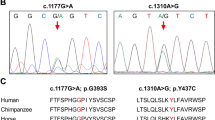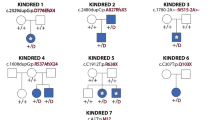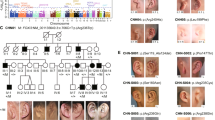Abstract
Neural tube defects (NTDs) such as spina bifida and anencephaly are common congenital malformations in humans (1/1,000 births) that result from failure of the neural tube to close during embryogenesis1,2. The etiology of NTDs is complex, with both genetic and environmental contributions; the genetic component has been extensively studied with mouse models3. Loop-tail (Lp) is a semidominant mutation on mouse chromosome 1 (ref. 4). In the two known Lp alleles (Lp, Lpm1Jus), heterozygous mice exhibit a characteristic looped tail, and homozygous embryos show a completely open neural tube in the hindbrain and spinal region, a condition similar to the severe craniorachischisis defect in humans4,5,6. Morphological and neural patterning studies indicate a role for the Lp gene product in controlling early morphogenesis and patterning of both axial midline structures and the developing neural plate7. The 0.6-cM/0.7-megabase (Mb) Lp interval is delineated proximally by D1Mit113/Apoa2/Fcer1g and distally by Fcer1a/D1Mit149/Spna1 and contains a minimum of 17 transcription units8,9,10,11. One of these genes, Ltap, encodes a homolog of Drosophila Strabismus/Van Gogh (Stbm/Vang), a component of the frizzled/dishevelled tissue polarity pathway12,13,14. Ltap is expressed broadly in the neuroectoderm throughout early neurogenesis and is altered in two independent Lp alleles, identifying this gene as a strong candidate for Lp.
This is a preview of subscription content, access via your institution
Access options
Subscribe to this journal
Receive 12 print issues and online access
$209.00 per year
only $17.42 per issue
Buy this article
- Purchase on Springer Link
- Instant access to full article PDF
Prices may be subject to local taxes which are calculated during checkout





Similar content being viewed by others
References
Copp, A.J., Brook, F.A., Estibeiro, J.P., Shum, A.S. & Cockroft, D.L. The embryonic development of mammalian neural tube defects. Prog. Neurobiol. 35, 363–403 (1990).
Campbell, L.R., Dayton, D.H. & Sohal, G.S. Neural tube defects: a review of human and animal studies on the etiology of neural tube defects. Teratology 34, 171–187 (1986).
Juriloff, D.M. & Harris M.J. Mouse models for neural tube closure defects. Hum. Mol. Genet. 9, 993–1000 (2000).
Strong, L.C. & Hollander, W.F. Hereditary Loop-tail in the house mouse. J. Hered. 40, 329–334 (1949).
Stein, K.F. & Rudin, I.A. Development of mice homozygous for the gene for Looptail. J. Hered. 44, 59–69 (1953).
Kibar, Z., Underhill, D.A., Canonne-Hergaux, F., Gauthier, S., Justice, M.J. & Gros, P. Identification of a new chemically-induced allele (Lpm1Jus) at the Loop-tail locus: morphology, histology and genetic mapping. Genomics 72, 331–337 (2001).
Greene, N.D., Gerrelli, D., Van Straaten, H.W. & Copp, A. J. Abnormalities of floor plate, notochord and somite differentiation in the loop-tail (Lp) mouse: a model of severe neural tube defects. Mech. Dev. 73, 59–72 (1998).
Mullick, A., Trasler, D. & Gros, P. High-resolution linkage map in the vicinity of the Lp locus. Genomics 26, 479–488 (1995).
Underhill, D.A., Mullick, A., Groulx, N., Beatty, B.G. & Gros P. Physical delineation of a 700-kb region overlapping the Looptail mutation on mouse chromosome 1. Genomics 55, 185–193 (1999).
Doudney, K. et al. Comparative physical and transcript maps of ∼1 Mb around loop-tail, a gene for severe neural tube defects on distal mouse chromosome 1 and human chromosome 1q22-q23. Genomics 72, 180–192 (2001).
Underhill, D.A., Vogan, K.J., Kibar, Z., Morrison, J., Rommens, J. & Gros, P. Transcription mapping and expression analysis of candidate genes in the vicinity of the mouse Loop-tail mutation. Mamm. Genome 11, 633–638 (2000).
Wolff, T. & Rubin, G.M. Strabismus, a novel gene that regulates tissue polarity and cell fate decisions in Drosophila. Development 125, 1149–1159 (1998).
Taylor, J., Abramova, N., Charlton, J. & Adler, P.N. Van Gogh: a new Drosophila tissue polarity gene. Genetics 150, 199–210 (1998).
Sokol, S. A role for Wnts in morphogenesis and tissue polarity. Nature Cell Biol. 2, E124–E126 (2000).
Kozak, M. An analysis of vertebrate mRNA sequences: intimations of translational control. J. Cell Biol. 115, 887–903 (1991).
Songyang, Z. et al. Recognition of unique carboxyl-terminal motifs by distinct PDZ domains. Science 275, 73–77 (1997).
Bonifacino, J.S. & Dell Angelica, E.C. Molecular bases for the recognition of tyrosine-based sorting signals. J. Cell Biol. 145, 923–926 (1999).
Letourneur, F. & Klausner, R.D. A novel di-leucine motif and a tyrosine-based motif independently mediate lysosomal targeting and endocytosis of CD3 chains. Cell 69, 1143–1157 (1992).
Chen, W.-J., Goldstein, J.L. & Brown, M.S. NPXY, a sequence often found in cytoplasmic tails is required for coated pit-mediated internalization of the low density lipoprotein receptor. J. Biol. Chem. 265, 3116–3123 (1990).
Fanning, A.S. & Anderson, J.M. PDZ domains: fundamental building blocks in the organization of protein complexes at the plasma membrane. J. Clin. Invest. 103, 767–772 (1999).
Djiane, A., Riou, J.-F., Umbhauer, M., Boucaut, J.-C. & Shi, D.-L. Role of frizzled 7 in the regulation of convergent extension movements during gastrulation in Xenopus laevis. Development 127, 3091–3100 (2000).
Heisenberg, C.-P., Tada, M., Rauch, G.-J., Saúde, L., Concha, M.L., Geisler, R., Stemple, D.L., Smith, J.C. & Wilson, S.W. Silberblick/Wnt11 mediates convergent extension movements during zebrafish gastrulation. Nature 405, 76–81 (2000).
Wallingford, J.B., Rowning, B.A., Vogeli, K.M., Rothbächer, U., Fraser, S.E. & Harland, R.M. Dishevelled controls cell polarity during Xenopus gastrulation. Nature 405, 81–85 (2000).
Smith, L.J. & Stein, K.F. Axial elongation in the mouse and its retardation in homozygous looptail mice. J. Embryol. Exp. Morphol. 10, 73–87 (1962).
Wilson, D.B. & Wyatt, D.P. Abnormal elevation of the neural folds in the loop-tail mutant mouse. Acta Anat. 143, 89–95 (1992).
Gerrelli. D. & Copp, A.J. Failure of neural tube closure in the loop-tail (Lp) mutant mouse: analysis of the embryonic mechanism. Dev. Brain Res. 102, 217–224 (1997).
Kyte, J. & Doolittle, R.F. A simple method for displaying the hydropathic character of a protein. J. Mol. Biol. 157, 105–132 (1982).
Thompson, J.D., Higgins, D.G. & Gibson, T.J. CLUSTAL W: improving the sensitivity of progressive multiple sequence alignment through sequence weighting, position-specific gap penalties and weight matrix choice. Nucleic Acids Res. 22, 4673–4680 (1994).
Wilkinson, D.G. & Nieto, M.A. Detection of messenger RNA by in situ hybridization to tissue sections and whole mounts. Methods Enzymol. 225, 361–373 (1993).
Wilkinson, D.G., Bhatt, S., Chavrier, P., Bravo, R. & Charnay, P. Segment-specific expression of a zinc-finger gene in the developing nervous system of the mouse. Nature 337, 461–464 (1989).
Acknowledgements
We thank M. Mathieu for expert technical assistance in DNA sequencing, D. Malo for supplying DNA from inbred strains and R. Krumlauf for providing the Krox20 probe. We especially thank C. Tabin for supporting aspects of this study in his laboratory and for providing helpful advice during the course of this work. The BAC clone was provided by the MRC Genome Resource Facility. This study was supported by grants from the Canadian Institute for Health Research (CIHR) of Canada (to P.G.) and NIH Public Health Service grant P01 CA75719 (to M.J). Z.K. is supported by a fellowship from the Fonds de la Recherche en Santé du Québec. K.J.V. is a Genetics Institute Fellow of the Life Sciences Research Foundation. D.A.U. is a Scholar of the Alberta Heritage Foundation for Medical Research. P.G. is supported by a Distinguished Scientist Award of the CIHR and is an International Scholar for the Howard Hughes Medical Institute.
Author information
Authors and Affiliations
Corresponding author
Rights and permissions
About this article
Cite this article
Kibar, Z., Vogan, K., Groulx, N. et al. Ltap, a mammalian homolog of Drosophila Strabismus/Van Gogh, is altered in the mouse neural tube mutant Loop-tail. Nat Genet 28, 251–255 (2001). https://doi.org/10.1038/90081
Received:
Accepted:
Issue Date:
DOI: https://doi.org/10.1038/90081
This article is cited by
-
Role of the Ror family receptors in Wnt5a signaling
In Vitro Cellular & Developmental Biology - Animal (2024)
-
USP39 is essential for mammalian epithelial morphogenesis through upregulation of planar cell polarity components
Communications Biology (2022)
-
Wnt/planar cell polarity signaling controls morphogenetic movements of gastrulation and neural tube closure
Cellular and Molecular Life Sciences (2022)
-
Planar cell polarity pathway in kidney development, function and disease
Nature Reviews Nephrology (2021)
-
Vangl2 promotes the formation of long cytonemes to enable distant Wnt/β-catenin signaling
Nature Communications (2021)



